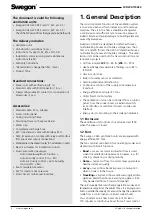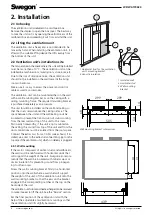
8
W3/W4.170420
All rights to changes reserved.
www.swegon.com
It is important to the ensure the tightness of the vapour
barrier at the penetration collars. We recommend the
use of a mounting frame with vapour barrier designed
for the ventilation unit (accessory, W3:PW080YP / W4:
PW100YP) for sealing the vapour barrier.
2.5.1 Enabling kitchen bypass
The ventilation unit has extra duct connection for ex-
tract air from the cooker hood. The extract air from the
cooker hood flows directly out through the unit’s extract
air fan and does not pass the heat exchanger. For this
reason, the kitchen’s general ventilation must not take
place via the cooker hood. On delivery, the duct outlet
that bypass the heat exchanger are fitted with cover.
The duct between the cooker hood and the unit must
be installed in such a way that it’s possible to clean it
from outside of the unit.
Important
The kitchen bypass is intended for use
when the air flows from the cooker hood/
kitchen are boosted. The kitchen’s general
ventilation must take place via the extract
air duct. If the general ventilation takes
place continuously via the cooker hood, the
supply air and extract air flows through the
heat exchanger will be out of balance, and
this will lower the efficiency and impair
the ventilation unit’s anti-freeze protection
functions during the winter.
!
!
2.5 Ducts
Important
Check whether the ventilation unit is a left
or right-hand version, to be sure to connect
the ventilation ducts to the correct duct
connections.
!
!
R. Right-hand version
L. Left-hand version
1. Supply air
2. Extract air
3. Outdoor air
4. Exhaust air
5. Extract air from the
cooker hood
Install the ducts according to the ventilation drawings.
Do not mount ducts directly against structural elements
to avoid the propagation of sound.
Insulate the ventilation ducts to prevent leakage of heat,
cold and sound, as well as water condensing. Fire insulate
the ducts according to national regulations.
Pay particular
attention to insulate cold ducts without gaps in the
insulation, so that moisture cannot condense.
The thickness of the insulation must be sufficient for the
insulation material, for the climate area and according
to local regulations. Most manufacturers of insulation
material offer calculation programs for the calculation of
correct and sufficient insulation.
Supply air duct should be fitted with acoustic insulation
along the stretch between the unit duct outlet and the
sound attenuator, so that fan sound will not be propa-
gated out into the room.
Generally, ventilation ducts should be insulated as follows:
• Insulate the outdoor ducts that pass through warm
spaces.
• Exhaust air ducts should always be insulated in ac-
cordance with national regulations.
• Insulate supply air ducts in cold spaces.
• Insulate extract air ducts in cold spaces.
• If the air inside the duct is colder than in the sur-
roundings; the insulation should be protected by a
vapour barrier.























